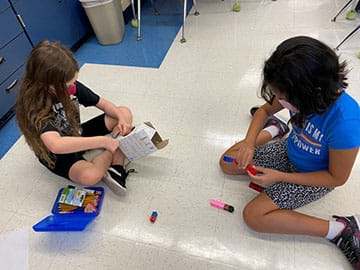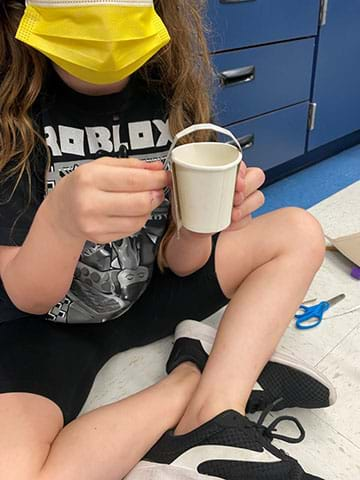Quick Look
Grade Level: 2 (1-3)
Time Required: 45 minutes
(time split into two 25-minute sessions)
Expendable Cost/Group: US $4.00
Group Size: 3
Activity Dependency: None
Subject Areas: Data Analysis and Probability, Life Science, Measurement, Reasoning and Proof
NGSS Performance Expectations:

| K-2-ETS1-1 |
| K-2-ETS1-2 |
Summary
Reduce, reuse, recycle—engineer! In this activity that focuses on environmental awareness, students research and read books about various items and buildings made from recycled or reused materials. They then plan, design, and construct a storage space for an individual snack using the engineering design process. They consider key elements such as temperature control, budget, materials, and size.
Engineering Connection
Environmental engineers work to improve recycling, waste disposal, public health, and water and air pollution control. They also address global issues, such as unsafe drinking water, climate change, and environmental sustainability. They use various materials in design and construction in virtually every aspect and specialty. The main goal for which they strive is to conserve and benefit the environment as much as possible.
Learning Objectives
After this activity, students should be able to:
- Define environmental conservation.
- Explain reducing, reusing, and recycling and their importance to the environmental conservation.
- Plan collaboratively.
- Apply the engineering design process.
- Measure materials using a ruler with both centimeters and inches.
- Build multiple iterations of their structure to find optimal results.
Educational Standards
Each TeachEngineering lesson or activity is correlated to one or more K-12 science,
technology, engineering or math (STEM) educational standards.
All 100,000+ K-12 STEM standards covered in TeachEngineering are collected, maintained and packaged by the Achievement Standards Network (ASN),
a project of D2L (www.achievementstandards.org).
In the ASN, standards are hierarchically structured: first by source; e.g., by state; within source by type; e.g., science or mathematics;
within type by subtype, then by grade, etc.
Each TeachEngineering lesson or activity is correlated to one or more K-12 science, technology, engineering or math (STEM) educational standards.
All 100,000+ K-12 STEM standards covered in TeachEngineering are collected, maintained and packaged by the Achievement Standards Network (ASN), a project of D2L (www.achievementstandards.org).
In the ASN, standards are hierarchically structured: first by source; e.g., by state; within source by type; e.g., science or mathematics; within type by subtype, then by grade, etc.
NGSS: Next Generation Science Standards - Science
| NGSS Performance Expectation | ||
|---|---|---|
|
K-2-ETS1-1. Ask questions, make observations, and gather information about a situation people want to change to define a simple problem that can be solved through the development of a new or improved object or tool. (Grades K - 2) Do you agree with this alignment? |
||
| Click to view other curriculum aligned to this Performance Expectation | ||
| This activity focuses on the following Three Dimensional Learning aspects of NGSS: | ||
| Science & Engineering Practices | Disciplinary Core Ideas | Crosscutting Concepts |
| Ask questions based on observations to find more information about the natural and/or designed world(s). Alignment agreement: Define a simple problem that can be solved through the development of a new or improved object or tool.Alignment agreement: | A situation that people want to change or create can be approached as a problem to be solved through engineering. Alignment agreement: Asking questions, making observations, and gathering information are helpful in thinking about problems.Alignment agreement: Before beginning to design a solution, it is important to clearly understand the problem.Alignment agreement: | |
| NGSS Performance Expectation | ||
|---|---|---|
|
K-2-ETS1-2. Develop a simple sketch, drawing, or physical model to illustrate how the shape of an object helps it function as needed to solve a given problem. (Grades K - 2) Do you agree with this alignment? |
||
| Click to view other curriculum aligned to this Performance Expectation | ||
| This activity focuses on the following Three Dimensional Learning aspects of NGSS: | ||
| Science & Engineering Practices | Disciplinary Core Ideas | Crosscutting Concepts |
| Develop a simple model based on evidence to represent a proposed object or tool. Alignment agreement: | Designs can be conveyed through sketches, drawings, or physical models. These representations are useful in communicating ideas for a problem's solutions to other people. Alignment agreement: | The shape and stability of structures of natural and designed objects are related to their function(s). Alignment agreement: |
Common Core State Standards - Math
-
Measure the length of an object by selecting and using appropriate tools such as rulers, yardsticks, meter sticks, and measuring tapes.
(Grade
2)
More Details
Do you agree with this alignment?
International Technology and Engineering Educators Association - Technology
-
Students will develop an understanding of the attributes of design.
(Grades
K -
12)
More Details
Do you agree with this alignment?
-
Students will develop an understanding of engineering design.
(Grades
K -
12)
More Details
Do you agree with this alignment?
-
Students will develop an understanding of the role of troubleshooting, research and development, invention and innovation, and experimentation in problem solving.
(Grades
K -
12)
More Details
Do you agree with this alignment?
State Standards
Florida - Math
-
Measure the length of an object to the nearest inch, foot, centimeter, or meter by selecting and using appropriate tools such as rulers, yardsticks, meter sticks, and measuring tapes.
(Grade
2)
More Details
Do you agree with this alignment?
Materials List
Each group needs:
- science notebook (one for each student)
- ruler
- small individually wrapped snacks like granola bars or crackers.
- adhesives, such as tape or glue
- various recycled or reusable materials, including but not limited to:
- newspapers
- paper towel or toilet paper rolls
- fabric scraps
- cardboard
- pipe cleaners
- wooden rods
- other crafting supplies
Worksheets and Attachments
Visit [www.teachengineering.org/activities/view/uof-2629-snack-holder-recycled-materials-design-activity] to print or download.Pre-Req Knowledge
An understanding of reusing and recycling, measuring using a ruler with inches and centimeters, as well as the importance of environmental conservation.
Introduction/Motivation
What is the difference between throwing something away and recycling? Why do we recycle? What are the benefits for the world around us? What are some ways we can reduce, reuse or recycle? Environmental conservation is the act of preserving, guarding, or protecting the world around us and keeping it in a safe state.
One way to help conserve the environment is to use materials that we already have. We can clean and reuse materials, such as plastic bottles or scraps of fabric. We can also be sure to recycle items such as aluminum cans, cartons from the cafeteria, or paper. When we reuse and recycle, we are reducing the use of manmade materials and that helps to protect the environment. This must be part of our everyday practices and procedures.
Today you all become environmental engineers and you have a problem to solve! Many kids in the United States use plastic baggies to hold their snacks when they need to take their snacks from one place to another. However, these plastic baggies eventually end up in the landfill and take 1,000 years to decompose. 1,000 years!
How can we keep environmental conservation in mind while creating and constructing something that will act as storage for our snacks? That’s right! We can reuse materials and/or use recycled materials to build a structure that will hold our yummy snacks. We need to consider protection from outside elements, the materials that we use, and possible temperature control.
We will be acting as environmental engineers and use the engineering design process to do this because the main goal of environmental engineering is to create and figure out various ways to help conserve and better our environment.
Procedure
Background
What are examples of items that can be recycled? Why is it important to make sure that we don’t throw everything away and, instead, reuse and recycle items? Choose from one or more of the following resources for videos and more background information:
- Recycling Facts Video - https://www.youtube.com/watch?v=7UuUeoyYmxI
- Recycling Video 2 - https://www.youtube.com/watch?v=6jQ7y_qQYUA
- 16 Recycling Facts - https://recyclingpartnership.org/communitiesforrecycling/16-fun-recycling-facts-for-kids/
- The Environment: Recycling - https://www.ducksters.com/science/environment/recycling_for_kids.php
Before the Activity
- Give the Recycling Sort Pre-Assessment
- Gather recyclable/reusable materials
With the Students
- Divide the class into teams of two or three students each.
- (Ask) Set up the design challenge and constraints to the students:
- State the design challenge: design and construct a structure that can hold snacks.
- Show the students the available materials.
- Tell them the constraints of the design project: the structure should stand on its own, hold the snack without damaging it, and should be able to fit in their desks and/or cubbies.
- Have students get their science journals out.
- (Brainstorm) Direct groups to brainstorm ideas of how to construct something that will act as storage for their snacks. Have student record their brainstormed ideas into their science notebooks.
- Have student groups share their brainstormed ideas with another group.
- Instruct students to pick one idea they want to build.
- (Plan) Have students sketch out their prototype blueprint for their snack holder in their science notebooks. Tell students to color or label the different materials they plan to use in their sketch.


- (Create) Let students use the recyclable and reusable materials to build a structure that will hold their snack.
- (Test) Test how the prototype snack structure works. The structure should stand on its own, hold the snack without damaging it, and should be able to fit in their desks and/or cubbies.
- (Improve) Based on the testing, have students plan, design and improve upon their initial design/structure. Make sure students record all improvements and updates to their initial designs in their notebooks.
- Repeat steps 7 through 10 two more times.
- (Communicate) Have each student group present their initial design, explaining the improvements they made, what worked and what didn’t work.

Vocabulary/Definitions
centimeter: A unit length that is one 100th of a meter.
environmental conservation: The act of preserving, guarding, or protecting; the keeping the world around us in a safe state.
inch: A unit of length that is 1/12 of a foot and equivalent to 2.54 centimeters.
recycle: To treat or process used or waste materials to make suitable for reuse.
reduce: To bring down to a smaller extent, size, amount, number.
reuse: To use again.
Assessment
Pre-Activity Assessment
Pre-Assessment: Give the Recycling Sort Pre-Assessment after providing background knowledge and before completing the activity.
Activity Embedded (Formative) Assessment
Notebooks: Students record all plans and measurements in science notebooks.
Post-Activity (Summative) Assessment
Presentations: Student presentation of their snack design. Presentations include design plan and sketch, all iterations, final structures, and how to use the container if there's a door or lid.
Safety Issues
Find alternate materials if any students have allergies to any materials being tested.
Troubleshooting Tips
Teachers might want to begin gathering materials a few weeks before conducting the activity.
Subscribe
Get the inside scoop on all things TeachEngineering such as new site features, curriculum updates, video releases, and more by signing up for our newsletter!More Curriculum Like This

Students expand their understanding of solid waste management to include the idea of 3RC: reduce, reuse, recycle and compost. They look at the effects of packaging decisions (reducing) and learn about engineering advancements in packaging materials and solid waste management.
Copyright
© 2021 by Regents of the University of Colorado; original © 2021 University of FloridaContributors
Chelsey Simmons, PI, University of Florida MRET Program; Ryan Pacheco, 1st grade classroom teacherSupporting Program
Multidisciplinary Research Experiences for Teachers of Elementary Grades, Herbert Wertheim College of Engineering, University of FloridaAcknowledgements
This curriculum was based upon work supported by the National Science Foundation under RET grant no. EEC 1711543— Engineering for Biology: Multidisciplinary Research Experiences for Teachers in Elementary Grades (MRET) through the College of Engineering at the University of Florida. Any opinions, findings, and conclusions or recommendations expressed in this material are those of the authors and do not necessarily reflect the views of the National Science Foundation.
Last modified: March 17, 2022







User Comments & Tips